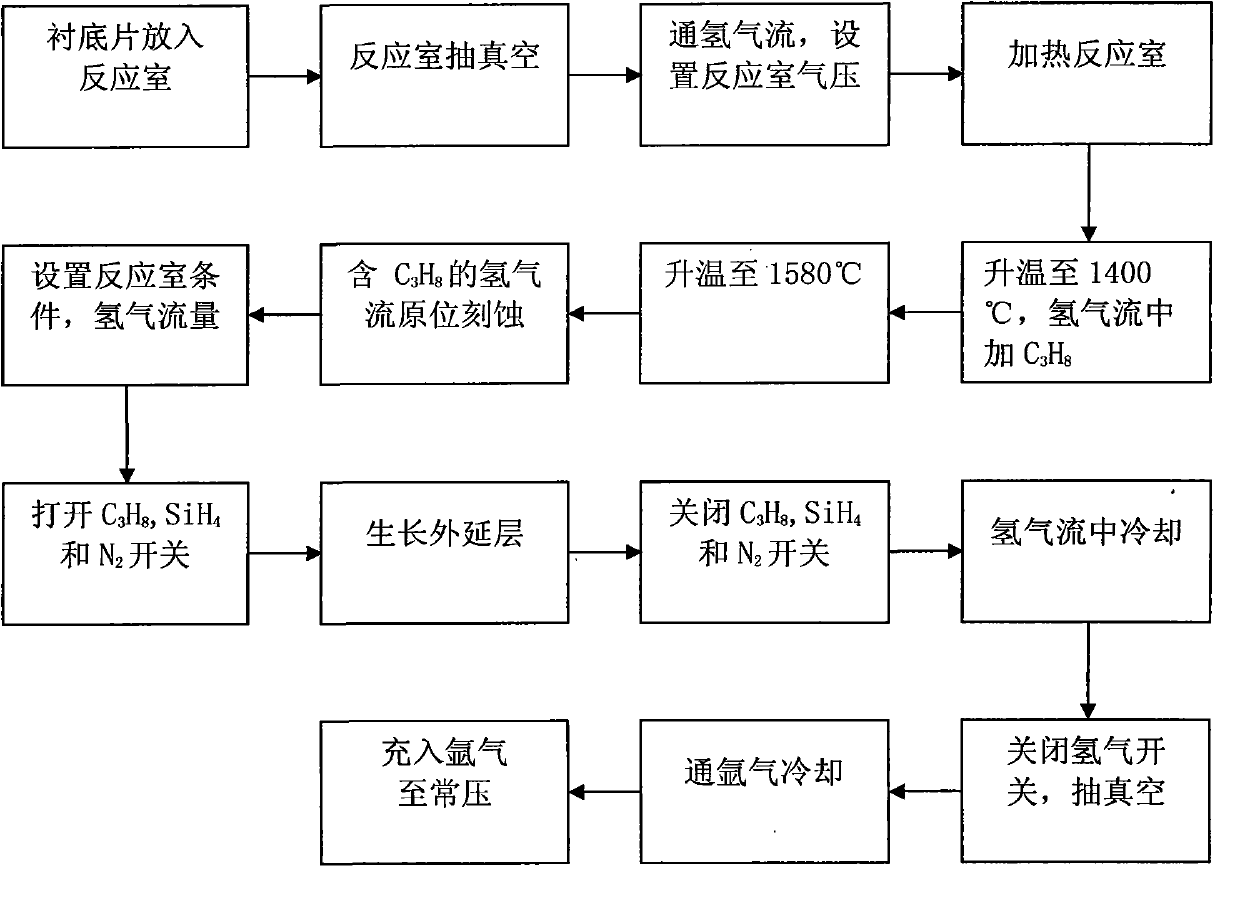Method for controlling N-type 4H-SiC homogenous epitaxial doping
A technology of homoepitaxy and control methods, applied in the directions of diffusion/doping, chemical instruments and methods, from chemically reactive gases, etc., to achieve the effect of simplifying the preparation process, reducing defects, and improving device performance
- Summary
- Abstract
- Description
- Claims
- Application Information
AI Technical Summary
Problems solved by technology
Method used
Image
Examples
Embodiment 1
[0026] Step 1, placing the silicon carbide substrate into the reaction chamber of the silicon carbide CVD equipment.
[0027] (1.1) Selection bias A 4H silicon carbide substrate with a crystal orientation of 8° is placed in the reaction chamber of the silicon carbide CVD equipment;
[0028] (1.2) Vacuumize the reaction chamber until the pressure in the reaction chamber is lower than 1×10 -7 mbar.
[0029] Step 2, heating the reaction chamber in the hydrogen flow.
[0030] (2.1) Open the hydrogen switch leading to the reaction chamber, and control the hydrogen flow to gradually increase to 80L / min;
[0031] (2.2) Turn on the vacuum pump to extract the gas in the reaction chamber, and keep the reaction chamber pressure at 300mbar;
[0032] (2.3) Gradually increase the power of the heating source to slowly increase the temperature of the reaction chamber. When the temperature exceeds 1400°C, add C with a flow rate of 5mL / min into the hydrogen flow. 3 h 8 .
[0033] Step 3...
Embodiment 2
[0049] Step 1, choose the direction The 4H silicon carbide substrate with a crystal orientation of 8° is placed in the reaction chamber of the silicon carbide CVD equipment; the reaction chamber is evacuated until the pressure of the reaction chamber is lower than 1×10 -7 mbar.
[0050] Step 2, open the H to the reaction chamber 2 Switch, control the hydrogen flow to gradually increase to 80L / min, and at the same time turn on the vacuum pump to extract the gas in the reaction chamber, keeping the pressure of the reaction chamber at 500mbar; gradually increase the power of the RF heating source to slowly increase the temperature of the reaction chamber, when the temperature of the reaction chamber After reaching 1400°C, add C with a flow rate of 7mL / min into the hydrogen flow 3 h 8 .
[0051] Step 3, when the temperature of the reaction chamber reaches 1580°C, keep the temperature of the reaction chamber constant, and keep the flow rate of 80L / min H 2 and C at a flow rate o...
Embodiment 3
[0056] The first step is to choose a bias The 4H silicon carbide substrate with a crystal orientation of 8° is placed in the reaction chamber of the silicon carbide CVD equipment; the reaction chamber is evacuated until the pressure of the reaction chamber is lower than 1×10 -7 mbar.
[0057] In the second step, open the H to the reaction chamber 2 Switch, control the hydrogen flow to gradually increase to 80L / min, and at the same time turn on the vacuum pump to extract the gas in the reaction chamber, keeping the pressure of the reaction chamber at 700mbar; gradually increase the power of the RF heating source to slowly increase the temperature of the reaction chamber, when the temperature of the reaction chamber After reaching 1400°C, add C with a flow rate of 10mL / min into the hydrogen flow 3 h 8
[0058] In the third step, the substrate is etched in situ.
[0059] (3.1) When the reaction chamber temperature reaches 1600°C, keep the reaction chamber temperature consta...
PUM
 Login to View More
Login to View More Abstract
Description
Claims
Application Information
 Login to View More
Login to View More - R&D
- Intellectual Property
- Life Sciences
- Materials
- Tech Scout
- Unparalleled Data Quality
- Higher Quality Content
- 60% Fewer Hallucinations
Browse by: Latest US Patents, China's latest patents, Technical Efficacy Thesaurus, Application Domain, Technology Topic, Popular Technical Reports.
© 2025 PatSnap. All rights reserved.Legal|Privacy policy|Modern Slavery Act Transparency Statement|Sitemap|About US| Contact US: help@patsnap.com


